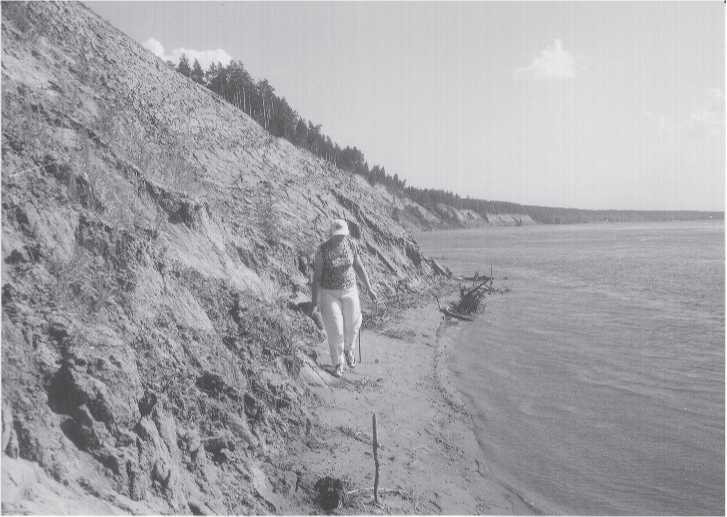Krasny Yar (Red or Beautiful Gully) is a deeply buried river bank Pleistocene palento-logical deposit that accumulated before the overlying near-vertical 30 m bluff - made up of sandy loams, loess-like loams, sand, and silty sedimentary deposits - was laid down (Fig. 3.48). The locality is at 55°02' N, 82°55' E on the right bank of the Ob River, 17 km down-river from the main Novosibirsk railroad station. It is the type locality for the geological section of the Ob River Valley in the Novosibirsk region (Saks et al. 1978).
Sergei K. Vasiliev has repeatedly collected at the locality every year, starting in 1978 when he was in the sixth grade. He has recovered more than 2800 whole bones and fragments belonging to 20 mammalian species, all of which will be the basis for his Doctor of Science dissertation. Even with his fTequent visits and studies at Krasny Yar, where he collects newly exposed bones before they can be washed down-river, it is apparent that the substantial abrasion and polishing of the largely whole bones means that they had washed out from somewhere else up-river, and deposited during the later Pleistocene at the present co-mingled bone bed. Hence, none of the Krasny Yar fossil remains represent in situ deaths, and water transport could have been a major contributor to the perimortem and postmortem taphonomy. Not being an archaeological site, there has been no excavation, only shoreside surface collecting (Fig. 3.49).
Vasiliev divides the collection into three groups based mainly on preservation. The best preserved, and presumably the youngest, has been carbon-14 dated between 28 000 and 33 000 BP. The second group is dated to Kazantsev times, as suggested by preservation and the morphological features of some species. The most poorly preserved pieces are considered to be the oldest, with a tentative date of ca. 80 000 BP.
Vasiliev (1995, 2002) has to date identified the following species and specimen numbers in levels designated 6 and 4: hare (Lepus timidus) L6 (1), L4 (2); marmot (Marmota baibacina) L6 (1), L4 (1); beaver (Castorfiber) L6 (0), L4 (11); gray wolf (Canis lupus) L6 (1), L4 (9); brown bear (Ursus arctos) L6 (1), L4 (8); wolverine (Gulo gulo) L6 (0), L4 (1); badger (Meles meles) L6 (0), L4 (1); cave hyena (Crocuta spelaea) L6 (10), L4 (1); cave lion (Panthera spelaea) L6 (6), L4 (10); mammut (Mammonteus primigenius) L6 (6), L4 (10); horse (Equus ex, gr, gallicus) L6 (401), L4 (443); rhinoceros (Coelodonta antiquitatis) L6 (65), L4 (151); big-horn deer (Megaloceros giganteus) L6 (0), L4 (160); red deer (Cervus elaphus) L6 (24), L4 (113); elk

Fig. 3.48 Rrasny Yar locality. Situated near the water’s edge of the Ob River, 15 km north (right bank, down-river) of Novosibirsk, this paleontological site is a classic example of taphonomic burial processes that interested I. A. Yefremov (Fig. 1.24). Krasny Yar has been watched over and collected by paleontologist Sergei Konstatinovich Vasilev for several years. He has amassed hundreds of animal bones that had washed into the Pleistocene river shore site. He recently discovered a nearly complete mammoth skull. In this image, fossil mammoth specialist Irina V. Foronova looks for additional Krasny Yar fossils along the narrow beach at the base of the high loess bluffs. While Krasny Yar is obviously a paleontological site, its bone damage was overwhelmingly done by mechanical means - water tumbling, ice crushing, trampling, surface weathering, sand and water polishing mixtures, and other mechanisms prior to deposition. Its perimortem taphonomic damage is markedly different from the paleontological bone accumulations such as Razboinich’ya hyena cave. The ultimate source of the Krasny Yar bones would likely have been natural deaths near to and up-river, deaths like the one illustrated in Figs. 2.5- 2.8 that might have washed into the Ob River from lateral streams and rivers such as the slow-moving muddy right bank Inya River between Academgorodok and Novosibirsk (CGT neg. Krasny Yar 7-7-00:3).
(Alces sp.) L6 (13), L4 (111); caribou (Rangifer tarandus) L6 (12), L4 (0); bison (Bison priscus) L6 (103), L4 (1080); saiga (Saiga tatarica) L6 (4), L4 (3). The collection is housed at IAE.




 World History
World History









